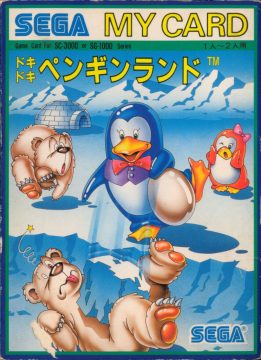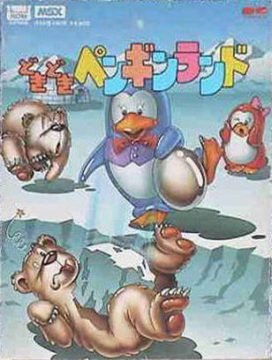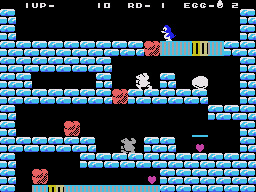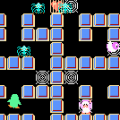It seems weird, looking back at Doki Doki Penguin Land now. Hisao Oguchi inherited the presidency over Sega Corporation in 2003, and also assumed position as Chief Creative Officer and Director at Sega Sammy Holdings after the merger. This guy is as big as they get in the business – and back in 1985, he started his career designing a cute little puzzle game starring a cartoon penguin named Adelie and his egg.
Penguin Land is all about pushing said egg down to the bottom of an improbable roof structure, until it reaches the penguin’s living room, where his wife awaits it. The defining characteristic of the game lies in putting the focus on the egg, rather than the main character: The screen only scrolls as far as the egg falls. Should the penguin get too far ahead, he just reappears at the top of the screen. But he can’t just drop the egg anywhere; if it falls too far (indicated by a line three stories below it), it breaks, and the area is full of polar bears that aim to stop him. We shall excuse a 1980s Japanese game designer for putting together two animals whose habitats couldn’t have been further away from each other, but that is only the start of it: When the penguin leaves his freight too far behind, moles come digging out of the brickwork and try to snatch it. Fortunately, they are real cowards who beat it as soon as the penguin reaches them, but the bears beat him in a fistfight any time, so he has to take them out by dropping rocks on them, or dig holes for them to step into.
The trick to each obstacle is usually smart digging to create a viable way for the egg, using rocks as possible platforms to catch its fall. There are also solid floors that can’t be dug through. Most of them have trap doors where the penguin can drop his egg, but he has to find another way for himself, potentially putting it in danger. There are also hearts floating around the levels, but they’re merely for scorekeeping. The penguin can’t technically die, and only stays incapacitated for a couple of seconds after getting hit. Only the loss of an egg forces a level restart.
So if this is a thrilling tale of a father and his struggle to reunite his family, one has to wonder about many things: How did the egg get outside in the first place, so far away from its mother? What are all these polar bears doing in the penguin’s dwelling? And how can he risk dropping his unborn offspring around a brick wall? Until one learns of the shameful truth:
He’s smuggling jewelry for his wife!
That puts the seemingly simple game in a whole new perspective: The player actually takes the role of a criminal, who tries to get his goods past the polar border patrol to his female accomplice. That also explains why they never kill him, and only try to stop him and take away the egg, whereas he resorts to cold blooded murder to reach his goal. Dear Mr. Oguchi, you sure created one of the darkest video games of 1985!
Silly overanalyzing aside, Doki Doki Penguin Land is more challenging than its looks suggest. It has some really tricky parts that require some brain work, but also plenty of dull stretches. The concept of protecting the egg feels fresh and unconsumed, even more than two decades later, and it can be a lot of fun messing around with the physics, but the few cool mechanics have a hard time carrying the game at its deliberate pace through the 25 levels.
There are no new tricks, no new enemies introduced, only iterations of the same principles – which is typical of many great puzzle games. But Penguin Land is only half puzzle game, and the other half could have used some more variety. Often it’s also not quite obvious which way is the best until the egg falls. It’s easy to get oneself stuck in a dead end, even though the game takes its time to slowly scroll down and up the whole stage at the beginning. Having to restart a level after losing on the last few feet can also be quite frustrating, especially with the sometimes wonky egg physics. At least the game comes with a level select option, so no one needs to rely on the three spare eggs to get on with the game, unless going for score.
When Hisao Oguchi first laid out his plans for what would eventually become Doki Doki Penguin Land, he called the game by a different name, which roughly translates to “Love War in the Penguin Village!” A page of his original design document suggests that the game itself started out very differently, too: The scene suggests a more straightforward platformer, with horizontal scrolling, slants for the hero to slide down, and even an object that looks like a healing item. The only familiar elements are the enemy polar bear, and the pink penguin waiting at the end.
Links:
Sega Classics Album Making of and interview with Hisao Oguchi (Japanese)
Doki Doki Penguin Land: Uchuu Daibouken (どきどきペンギンランド~宇宙大冒険~) / Penguin Land – Master System (1987)
The sequel takes the egg run into outer space – at least that puts aside the question whether the ice bears and penguins meet at the South Pole or the North Pole. This is not a completely random twist: The level start scene from the original game already shows a descending space ship in the background. The first failed attempt of the Penguin Land space program? During gameplay one wouldn’t notice the difference, only the cutscenes at the beginning and end of each stage hint at the setting. It’s pretty much the same deal as the first time, with some new twists: There is now a countdown timer, but it only affects scoring. Cracked bricks crumble when the egg is rolled over them, but strangely cannot be dug through otherwise. Alongside the trap doors for the egg now appear penguin-shaped ones, where only the protagonist fits through.
Finally, the stages gain some moving elements: Hovering platforms offer a new way of transportation, blocks that keep shrinking and growing enforce expert timing, and spikes smashing down from the ceiling become the meanest traps yet. A ghost also hides in some blocks, and turns Adelie into a Bad Penguin when it is freed. the little hero then puts on sunglasses and starts chain-smoking, squatting on the floor whenever he is idle. The bad news: This swaps around the controls for the remainder of the level. Only the moles from the original are gone, their place taken by eagles that drop bricks on the egg to punish uncaring players. In place of Adelie’s wife, three little penguin kids wait in some kind of space station at the end of each stage, to carry the egg away.
The level count is up to 50 now, with only the first 30 being selectable, so the final 20 have to be beaten in one painful run. At least the game offers the option to pause and scroll down the remainder of the level at any given time, putting less emphasis on memory and/or faith to get through. But the biggest feature of the Master System version is the level editor, although it doesn’t include all options: It isn’t possible to place the moving spikes, and there can be no more than five polar bears per level – a limitation the standard levels do not adhere to. It also takes a lot of care and revisiting to create levels that are even possible. Unfortunately, Uchuu Daibouken remains the only game in the series that has this feature.
Overall, the “Great Space Adventure” is a bit more exciting than its predecessor, but still suffers from a lack of new experiences throughout the game, with all elements once again introduced from the very first stage. While the original stayed in Japan, this game was the only entry in the entire series that was released internationally. In the West it was named just Penguin Land, making the whole space mission thing seem even weirder. Poor Adelie has it worse than his game, though: Marketing renamed him Overbite.
Penguin Land (ペンギンランド) – Game Boy (1990)
Maybe as a leftover from the MSX deal, Pony Canyon got the license to produce a version of Penguin Land for the Game Boy as well. Not quite a straight port, this version uses the 25 stages from the original, but mixes them up with the corroding floors and the eagles from the Master System game.
Unfortunately, the limited screen size and resolution make the Game Boy version the most frustrating of them all. One can barely see below the safe falling range of the egg, and while the penguin has the power to scroll the screen horizontally, the bottom of the screen is always dangerously close, making the undertaking much harder than it used to be. The game doesn’t even show the stage beforehand, like it did on the SG-1000. At least it is the first in the series to allow a selection of music. Two of the three tunes are even quite pleasant to listen to, other than the forgettable to annoying music that played throughout all of the console versions so far.
Even though the penguin on the cover looks sleazier than ever, Pony Canyon (or Atelier Double, the developer the program was outsourced to) got rid of the whole smuggling affair when translating the game. Now the penguin couple doesn’t break open the eggs for luxury goods, but rather stand around loving them.
Ikasuze! Koi no Doki Doki Penguin Land MD (イカスぜ!恋のどきどきペンギンランドMD) – Mega Drive SegaNet (1992), Mega CD (1994)
Like Flicky and Teddy Boy, Sega initially released the Mega Drive variant of Doki Doki Penguin Land through the SegaNet modem service, and only later made it onto Mega CD as part of the second Game no Kandume release. Now it’s time to “Chill Out!” cause it’s the “Throbbing of Love in Penguin Land” (this is what the title literally means). The hero this time is a young penguin that’s hopelessly in love with the penguin girl Pengo (subtle tie-in to the earlier Coreland-developed game with the same name?), the daughter of Adelie from the first game. The poor sap keeps bringing her flowers, and she rejects him every time. Why the presents have to be trafficked inside eggshells is just as well-explained as in the previous games, which of course means not at all.
The mechanics are just the same as the Space Adventure on Master System, with only a few exceptions. There are two new powerups that can be found hidden inside the walls: a pair of wings that improves the penguin’s jumping abilities and a steel eggshell that makes the freight temporarily indestructible. The eagles and ghosts are missing, leaving the bears as the sole antagonists this time.
There’s more of a consistent difficulty curve to the 30 stages this time, but to those familiar with the previous games the first half is going to be really easy. This incarnation is also more comfortable to use than any of the previous games. It’s possible to place a flag anywhere in a stage, which allows restarting at the exact same spot after losing the egg. There’s also an “Undo” function to revert the last manipulation of an object, be it a dig through the wrong piece of brickwork or a missed rock drop on a polar bear. On the down side, one can now only select stages that have been reached already since the system was turned on, but every five stages a password is shown. Otherwise there’s really not much to make this entry stand out from the rest, although it is definitely a well-composed sequel and more accessible than its predecessors.
Doki Doki Penguin Land: Arrange (どきどきペンギンランド: Arrange) – PlayStation 2 (2005)
Like almost all old Sega franchises, Penguin Land was pretty much finished after Sonic the Hedgehog appeared on the stage. A last swan song came with volume 23 of the Sega Ages 2500 series, which contained faithful recreations of five Sega classics, alongside so-called Arrange versions, which in some cases were essentially all-new games. The Arrange version of Penguin Land uses the same premise and concept as the SG-1000 original, but with completely new stages, new traps, enemies and power-ups.
Other than the old games, though, this remake doesn’t blow its load all at once. New elements keep being introduced for the first dozen stages, making for a much more exciting game. There is a new display that shows how much of a stage has been conquered so far, as well as a heart counter, which – once again – is only there for scoring. The final new display shows three slots of extra weapons. These include a flame that burns all obstacles immediately surrounding the egg, the return of the steel eggshell from the Mega Drive version (although it only breaks one fall now), and a set of spikes that can be used to ward off attackers should Adelie not be able to make it back in time.
When the player runs out of time, ghosts start appearing to attack the egg. They’re just as wimpy as the moles, but they can fly through all obstacles, which makes them the most dangerous adversaries in the game. The dopey-looking seals don’t bother the player, but slowly try to swallow the egg if they can reach it. An interesting new trap are the heat plates that cook the egg if it rests on them for too long. Pillows may save the egg from too high falls, but hilariously smash polar bears just like the rocks do.
The Arrange version is no doubt the most recommendable episode of Doki Doki Penguin Land, and the best way to get into the series. The difficulty starts out really moderate and takes its time to explore each new element before putting on some pressure. Slick (but humble) new graphics, a more exhilarating pace and an autosave function make sure new players aren’t alienated too much by outdated old school burdens, although it lacks the convenient flag and undo functions of the Mega Drive version. The background also stays the same throughout the game, and so does the music, which is a remix of the SG-1000 version tune. This is meant to be a remake of the original, after all.
Rip-off: Duck / Duck Maze – NES (1987)
While there have been a number of infamous NES ports of some famous Sega arcade games by courtesy of Tengen, it was left to the bootleggers to bring Penguin Land to the Nintendo platform – as a duck! Programmed by Bit Corp, who had been around since the Atari 2600 days (who doesn’t remember the phenomenal Bobby is Going Home?), the title screen shows a 1987 copyright, which would make it one of the earliest unlicensed NES games in existence. The known Australian release, which changes the name to Duck Maze only on the box cover, was released in 1990, though.
Even though the hero is now a duck fighting bulldogs and mice, the concept is the exact same as the SG-1000 release, without any new ideas or even any of the added elements from later ports. It has its own original set of stages, but there are only 20 of them. At the end awaits no wife for smuggled goods (gotta love it when a pirate rip-off schools the original game morally), but instead his offspring hatches at once, wearing a hat and a shirt at birth!
There is one big problem this clone has, and that’s the messed up physics. Jumping is extremely awkward, and it’s easy to accidentally push the egg in the wrong direction when jumping at it from above. It’s also easy to get the egg stuck by pushing it into a horizontal dead end with a brick tile above. While it’s possible to flip it out in all the official games, here it’s stuck forever, with suicide as the only option.
Screenshot Comparisons




